Highly Reliable Temperature Sensor Based on p-GaN/AlGaN/GaN Hybrid Anode Diode with Wide Operation Temperature from 73 K to 573 K
Abstract
1. Introduction
2. Materials and Methods
2.1. Epitaxial Structure
2.2. Device Structure and Manufacturing Methods
3. Results
3.1. Performance and Principle
3.2. Reliability and Comparison
4. Conclusions
Author Contributions
Funding
Conflicts of Interest
References
- Trung, T.Q.; Lee, N.-E. Flexible and Stretchable Physical Sensor Integrated Platforms for Wearable Human-Activity Monitoringand Personal Healthcare. Adv. Mater. 2016, 28, 4338–4372. [Google Scholar] [CrossRef]
- Blackburn, D. Temperature Measurements of Semiconductor Devices—A Review. In Proceedings of the 20th Annual IEEE Semiconductor Thermal Measurement and Management Symposium, San Jose, CA, USA, 9–11 March 2004; p. 70. [Google Scholar] [CrossRef]
- Udrea, F.; Santra, S.; Gardner, J.W. CMOS temperature sensors-Concepts, state-of-the-art and prospects. In Proceedings of the 31st International Semiconductor Conference, Sinaia, Romania, 13–15 October 2008; p. 31. [Google Scholar] [CrossRef]
- Kalker, S.; Ruppert, L.A.; van der Broeck, C.H.; Kuprat, J.; Andresen, M.; Polom, T.A.; Liserre, M.; De Doncker, R.W. Reviewing Thermal-Monitoring Techniques for Smart Power Modules. IEEE J. Emerg. Sel. Top. Power Electron. 2021, 10, 1326–1341. [Google Scholar] [CrossRef]
- Yang, F.; Pu, S.; Xu, C.; Akin, B. Turn-on Delay Based Real-Time Junction Temperature Measurement for SiC MOSFETs With Aging Compensation. IEEE Trans. Power Electron. 2020, 36, 1280–1294. [Google Scholar] [CrossRef]
- Chu, R. GaN power switches on the rise: Demonstrated benefits and unrealized potentials. Appl. Phys. Lett. 2020, 116, 090502. [Google Scholar] [CrossRef]
- Chen, K.J.; Haberlen, O.; Lidow, A.; Tsai, C.L.; Ueda, T.; Uemoto, Y.; Wu, Y. GaN-on-Si Power Technology: Devices and Applications. IEEE Trans. Electron Devices 2017, 64, 779–795. [Google Scholar] [CrossRef]
- Madhusoodhanan, S.; Sandoval, S.; Zhao, Y.; Ware, M.E.; Chen, Z. A Highly Linear Temperature Sensor Using GaN-on-SiC Heterojunction Diode for High Power Applications. IEEE Electron Device Lett. 2017, 38, 1105–1108. [Google Scholar] [CrossRef]
- Li, L.; Chen, J.; Gu, X.; Li, X.; Pu, T.; Ao, J.-P. Temperature sensor using thermally stable TiN anode GaN Schottky barrier diode for high power device application. Superlattices Microstruct. 2018, 123, 274–279. [Google Scholar] [CrossRef]
- Li, X.; Pu, T.; Li, L.; Ao, J.-P. Enhanced Sensitivity of GaN-Based Temperature Sensor by Using the Series Schottky Barrier Diode Structure. IEEE Electron Device Lett. 2020, 41, 601–604. [Google Scholar] [CrossRef]
- Li, X.; Pu, T.; Li, X.; Li, L.; Ao, J.-P. Correlation Between Anode Area and Sensitivity for the TiN/GaN Schottky Barrier Diode Temperature Sensor. IEEE Trans. Electron Devices 2020, 67, 1171–1175. [Google Scholar] [CrossRef]
- Li, X.; Pu, T.; Zhang, T.; Li, X.; Li, L.; Ao, J.-P. p-NiO/n-GaN Heterostructure Diode for Temperature Sensor Application. IEEE Sens. J. 2019, 20, 62–66. [Google Scholar] [CrossRef]
- Li, L.; Li, X.; Pu, T.; Cheng, S.; Li, H.; Ao, J.-P. Vertical GaN-Based Temperature Sensor by Using TiN Anode Schottky Barrier Diode. IEEE Sens. J. 2020, 21, 1273–1278. [Google Scholar] [CrossRef]
- Pu, T.; Li, X.; Wu, J.; Yang, J.; Lu, Y.; Liu, X.; Ao, J.-P. Recessed Anode AlGaN/GaN Schottky Barrier Diode for Temperature Sensor Application. IEEE Trans. Electron Devices 2021, 68, 5162–5166. [Google Scholar] [CrossRef]
- Li, L.; Pu, T.; Li, X.; Ao, J.-P. Effect of Anode Material on the Sensitivity of GaN Schottky Barrier Diode Temperature Sensor. IEEE Sens. J. 2021, 22, 1933–1938. [Google Scholar] [CrossRef]
- Kwan, A.M.H.; Guan, Y.; Liu, X.; Chen, K.J. A Highly Linear Integrated Temperature Sensor on a GaN Smart Power IC Platform. IEEE Trans. Electron Devices 2014, 61, 2970–2976. [Google Scholar] [CrossRef]
- Wei, X.; Zhang, X.; Zhou, X.; Ma, Y.; Tang, W.; Chen, T.; Liu, W.; Tang, W.; Yu, G.; Fan, Y.; et al. Dual Current and Voltage Sensitivity Temperature Sensor Based on Lateral p-GaN/AlGaN/GaN Hybrid Anode Diode. IEEE Sens. J. 2021, 21, 22459–22463. [Google Scholar] [CrossRef]
- Rajashekara, K.; Akin, B. A review of cryogenic power electronics—Status and applications. In Proceedings of the IEEE International Electric Machines and Drives Conference (IEMDC), Chicago, IL, USA, 12–15 May 2013; pp. 899–904. [Google Scholar] [CrossRef]
- Gui, H.; Chen, R.; Niu, J.; Zhang, Z.; Tolbert, L.M.; Wang, F.F.; Blalock, B.J.; Costinett, D.; Choi, B.B. Review of Power Electronics Components at Cryogenic Temperatures. IEEE Trans. Power Electron. 2019, 35, 5144–5156. [Google Scholar] [CrossRef]
- Nela, L.; Perera, N.; Erine, C.; Matioli, E. Performance of GaN Power Devices for Cryogenic Applications Down to 4.2 K. IEEE Trans. Power Electron. 2020, 36, 7412–7416. [Google Scholar] [CrossRef]
- Wei, X.; Shen, W.; Zhou, X.; Tang, W.; Ma, Y.; Chen, T.; Wang, D.; Fu, H.; Zhang, X.; Lin, W.; et al. 2.69 kV/2.11 mΩ∙cm2 and Low Leakage p-GaN Stripe Array Gated Hybrid Anode Diodes with Low Turn-on Voltage. IEEE Electron Device Lett. 2022, 44, 13–16. [Google Scholar] [CrossRef]
- Fu, H.; Fu, K.; Liu, H.; Alugubelli, S.R.; Huang, X.; Chen, H.; Montes, J.; Yang, T.-H.; Yang, C.; Zhou, J.; et al. Implantation-and etching-free high voltage vertical GaN p–n diodes terminated by plasma-hydrogenated p-GaN: Revealing the role of thermal annealing. Appl. Phys. Express 2019, 12, 051015. [Google Scholar] [CrossRef]
- Mansoor, M.; Haneef, I.; Akhtar, S.; De Luca, A.; Udrea, F. Silicon diode temperature sensors—A review of applications. Sens. Actuators A Phys. 2015, 232, 63–74. [Google Scholar] [CrossRef]
- Zhang, N.; Lin, C.-M.; Senesky, D.G.; Pisano, A.P. Temperature sensor based on 4H-silicon carbide pn diode operational from 20 °C to 600 °C. Appl. Phys. Lett. 2014, 104, 073504. [Google Scholar] [CrossRef]
- Schmitz, A.C.; Ping, A.T.; Khan, M.A.; Chen, Q.; Yang, J.W.; Adesida, I. Schottky barrier properties of various metals on n-type GaN. Semicond. Sci. Technol. 1996, 11, 1464–1467. [Google Scholar] [CrossRef]
- Bian, Z.; Su, K.; Zhang, J.; Zhao, S.; Zhou, H.; Zhang, W.; Zhang, Y.; Zhang, T.; Chen, J.; Dang, K.; et al. Gamma irradiation impact on GaN quasi-vertical Schottky barrier diodes. J. Phys. D Appl. Phys. 2019, 53, 045103. [Google Scholar] [CrossRef]
- De Luca, A.; Pathirana, V.; Ali, S.Z.; Udrea, F. Silicon on insulator thermodiode with extremely wide working temperature range. In Proceedings of the 2013 Transducers & Eurosensors XXVII: 17th International Conference on Solid-State Sensors, Actuators and Microsystems (Transducers & Eurosensors XXVII), Barcelona, Spain, 16–20 June 2013; p. 1911. [Google Scholar] [CrossRef]
- Wei, X.; Zhang, X.; Tang, W.; Liu, W.; Zhou, X.; Tang, W.; Ma, Y.; Chen, T.; Huang, X.; Qian, H.; et al. 2.0 kV/2.1 mΩ·cm2 Lateral p-GaN/AlGaN/GaN Hybrid Anode Diodes with Hydrogen Plasma Treatment. IEEE Electron Device Lett. 2022, 43, 693–696. [Google Scholar] [CrossRef]
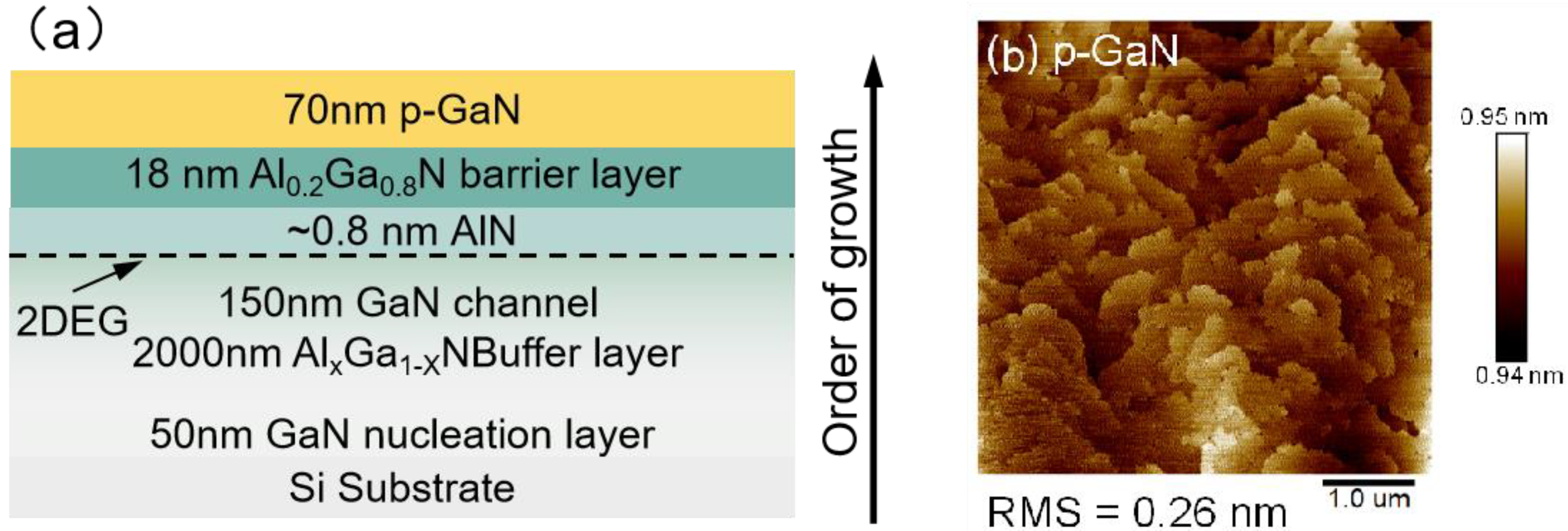
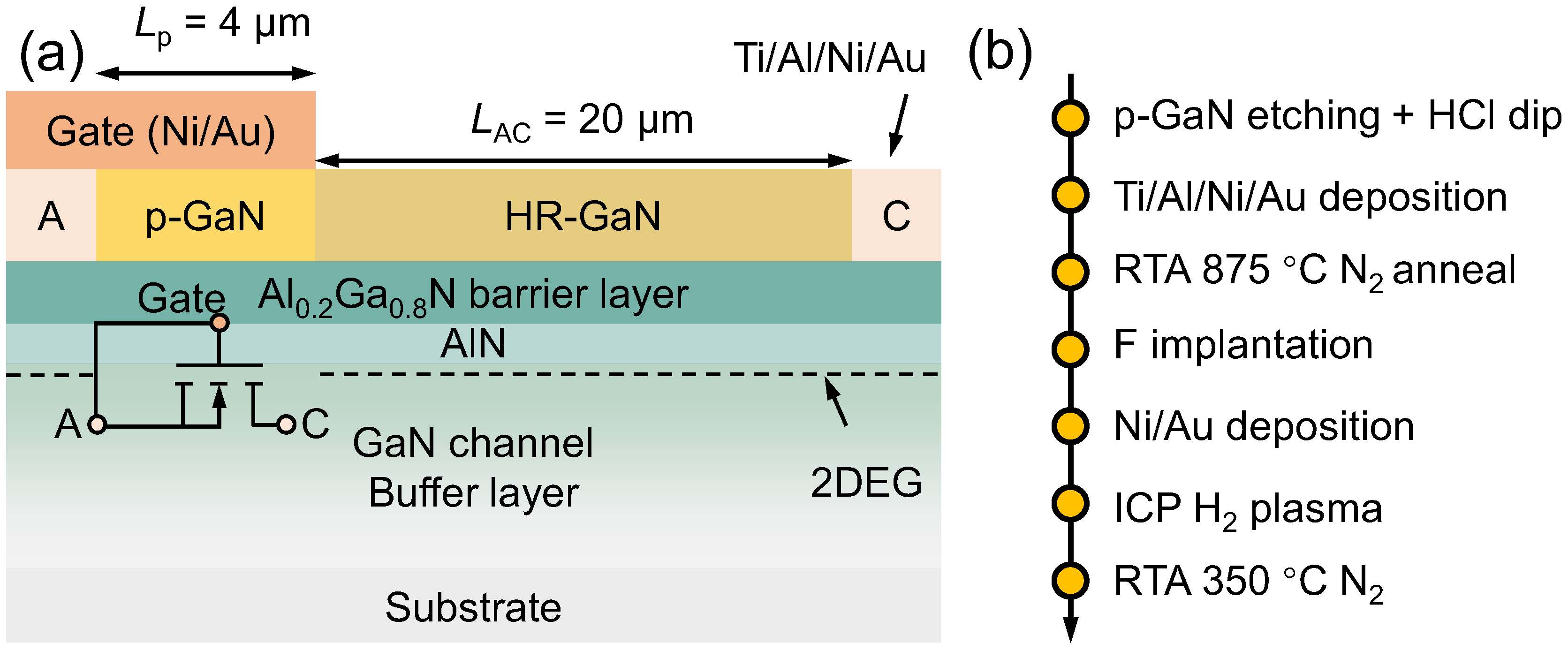
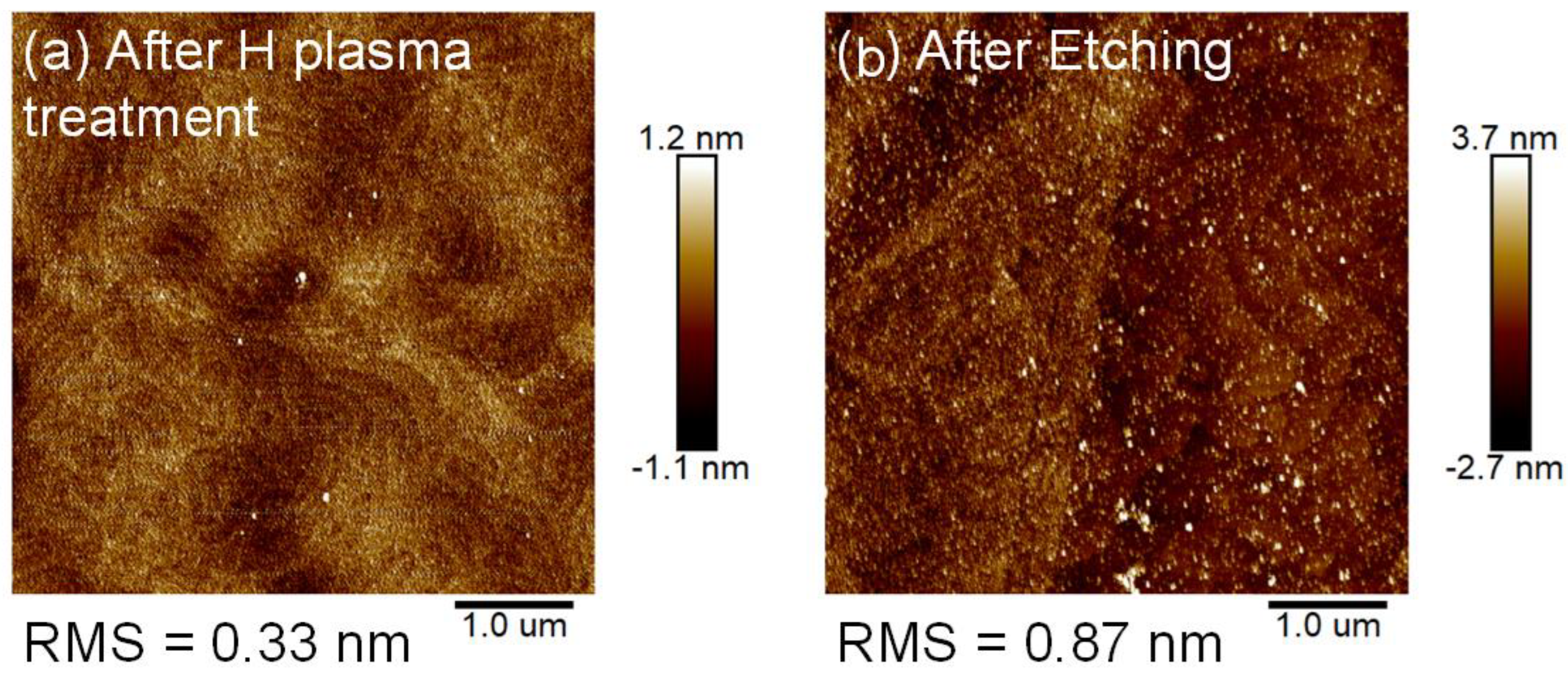
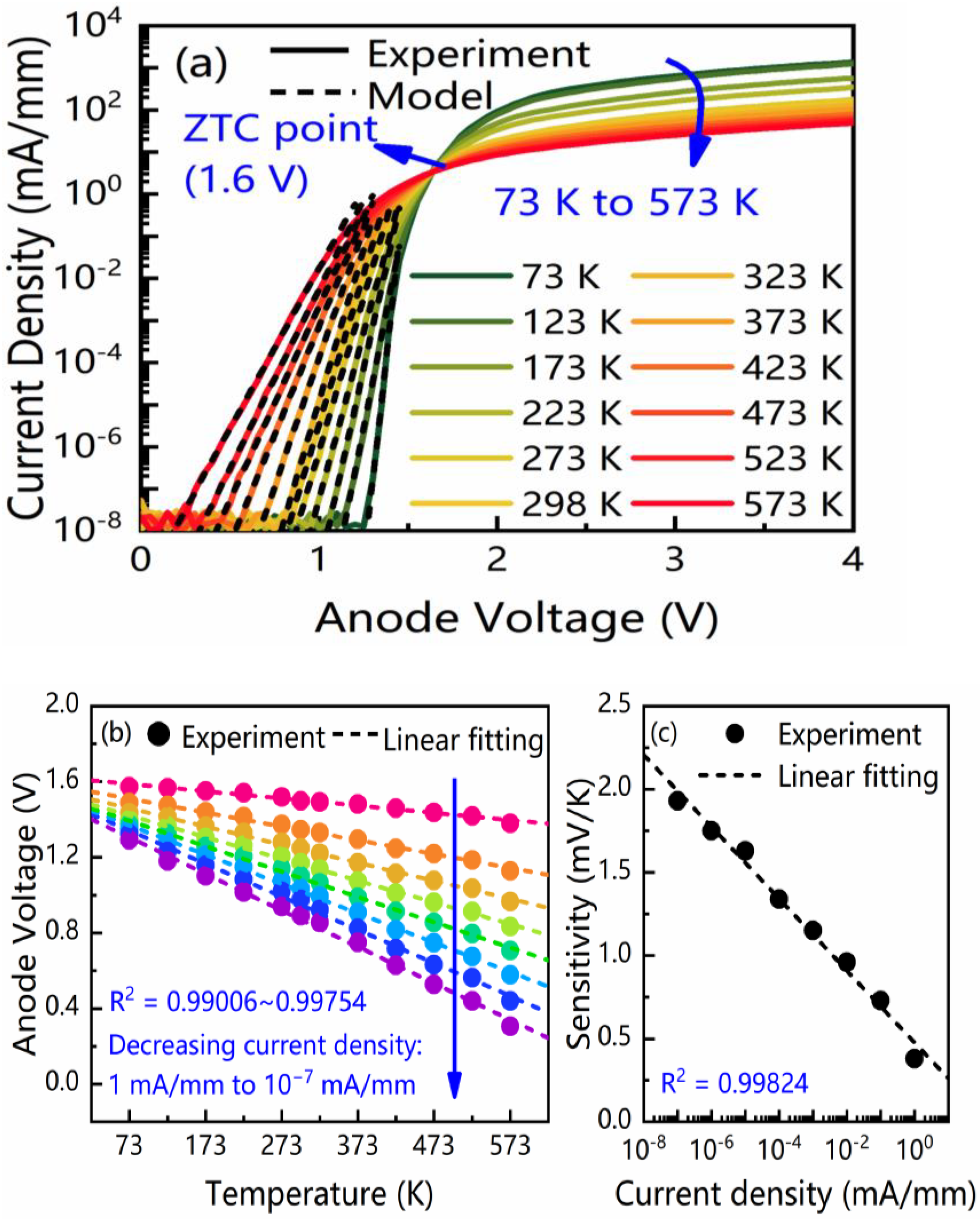

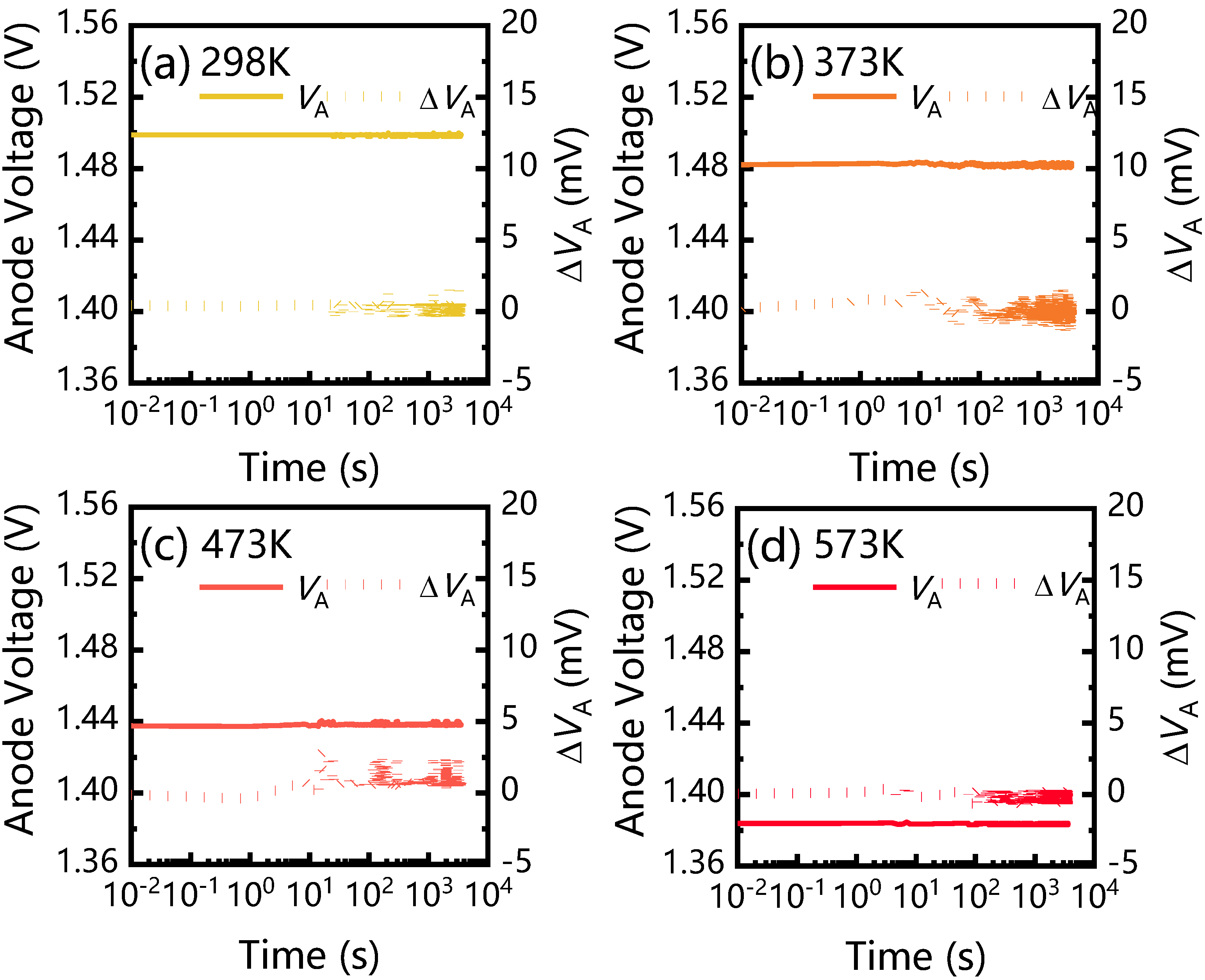
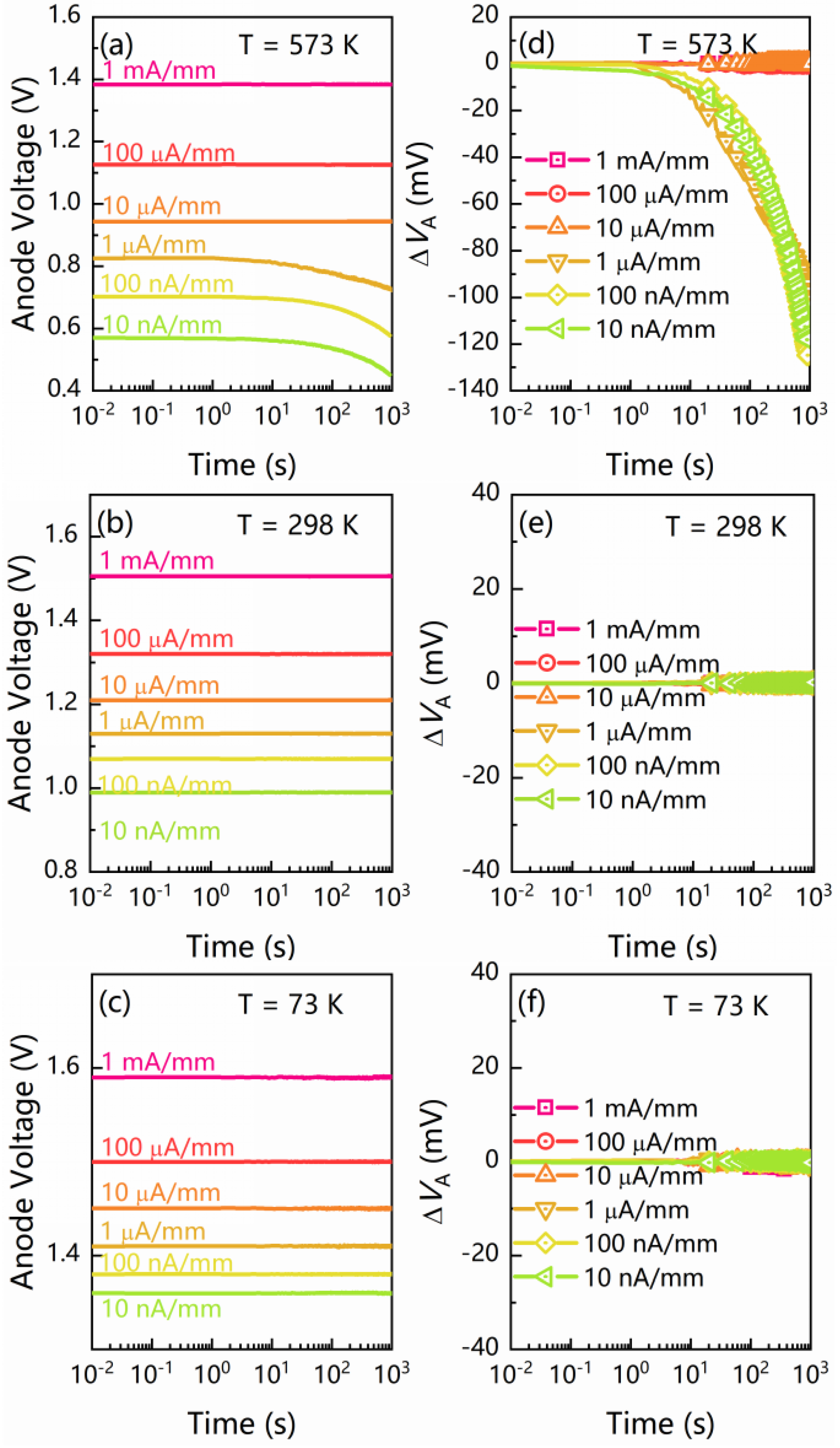
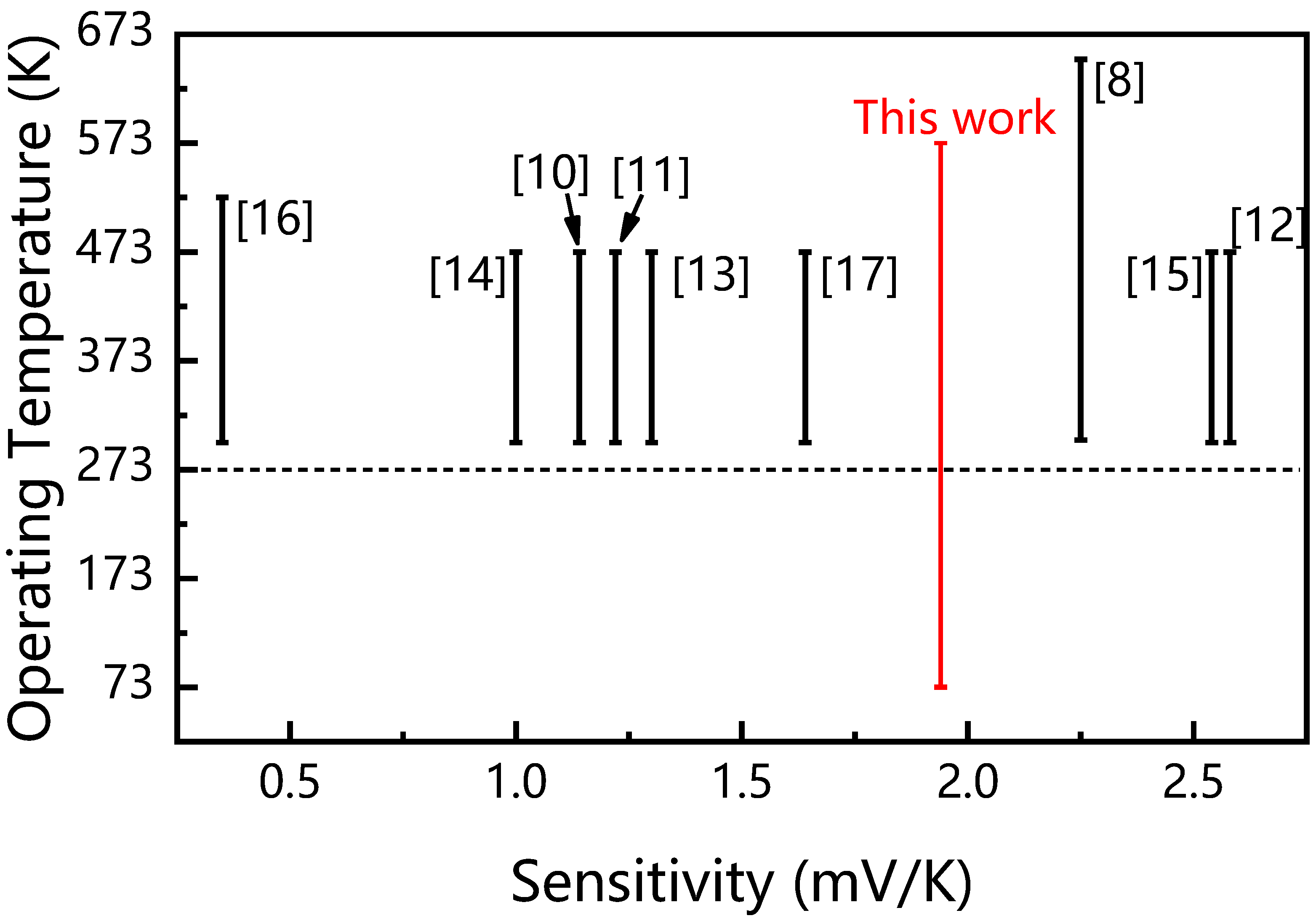
Disclaimer/Publisher’s Note: The statements, opinions and data contained in all publications are solely those of the individual author(s) and contributor(s) and not of MDPI and/or the editor(s). MDPI and/or the editor(s) disclaim responsibility for any injury to people or property resulting from any ideas, methods, instructions or products referred to in the content. |
© 2023 by the authors. Licensee MDPI, Basel, Switzerland. This article is an open access article distributed under the terms and conditions of the Creative Commons Attribution (CC BY) license (https://creativecommons.org/licenses/by/4.0/).
Share and Cite
Yang, A.; Wei, X.; Shen, W.; Hu, Y.; Chen, T.; Wang, H.; Zhou, J.; Xing, R.; Zhang, X.; Yu, G.; et al. Highly Reliable Temperature Sensor Based on p-GaN/AlGaN/GaN Hybrid Anode Diode with Wide Operation Temperature from 73 K to 573 K. Crystals 2023, 13, 620. https://doi.org/10.3390/cryst13040620
Yang A, Wei X, Shen W, Hu Y, Chen T, Wang H, Zhou J, Xing R, Zhang X, Yu G, et al. Highly Reliable Temperature Sensor Based on p-GaN/AlGaN/GaN Hybrid Anode Diode with Wide Operation Temperature from 73 K to 573 K. Crystals. 2023; 13(4):620. https://doi.org/10.3390/cryst13040620
Chicago/Turabian StyleYang, An, Xing Wei, Wenchao Shen, Yu Hu, Tiwei Chen, Heng Wang, Jiaan Zhou, Runxian Xing, Xiaodong Zhang, Guohao Yu, and et al. 2023. "Highly Reliable Temperature Sensor Based on p-GaN/AlGaN/GaN Hybrid Anode Diode with Wide Operation Temperature from 73 K to 573 K" Crystals 13, no. 4: 620. https://doi.org/10.3390/cryst13040620
APA StyleYang, A., Wei, X., Shen, W., Hu, Y., Chen, T., Wang, H., Zhou, J., Xing, R., Zhang, X., Yu, G., Fan, Y., Cai, Y., Zeng, Z., & Zhang, B. (2023). Highly Reliable Temperature Sensor Based on p-GaN/AlGaN/GaN Hybrid Anode Diode with Wide Operation Temperature from 73 K to 573 K. Crystals, 13(4), 620. https://doi.org/10.3390/cryst13040620





